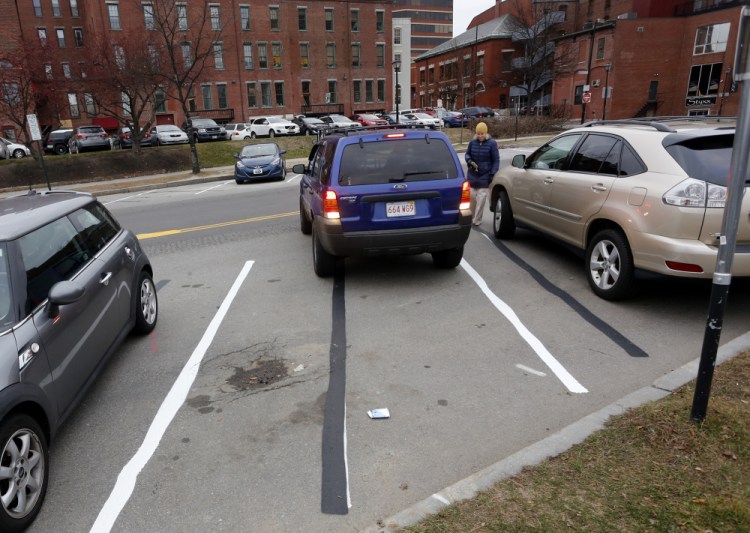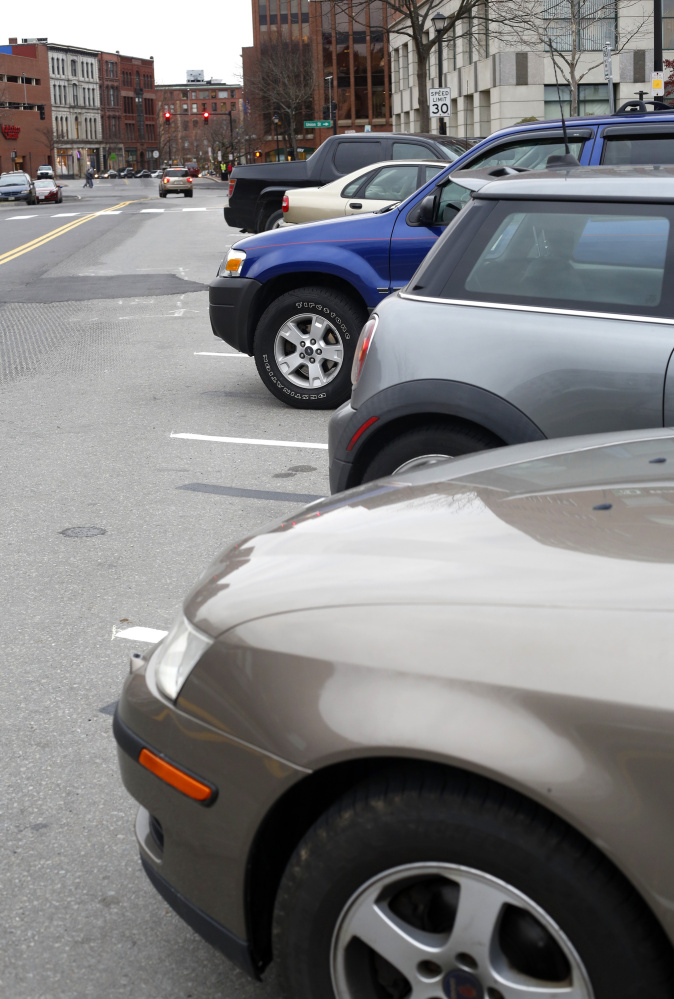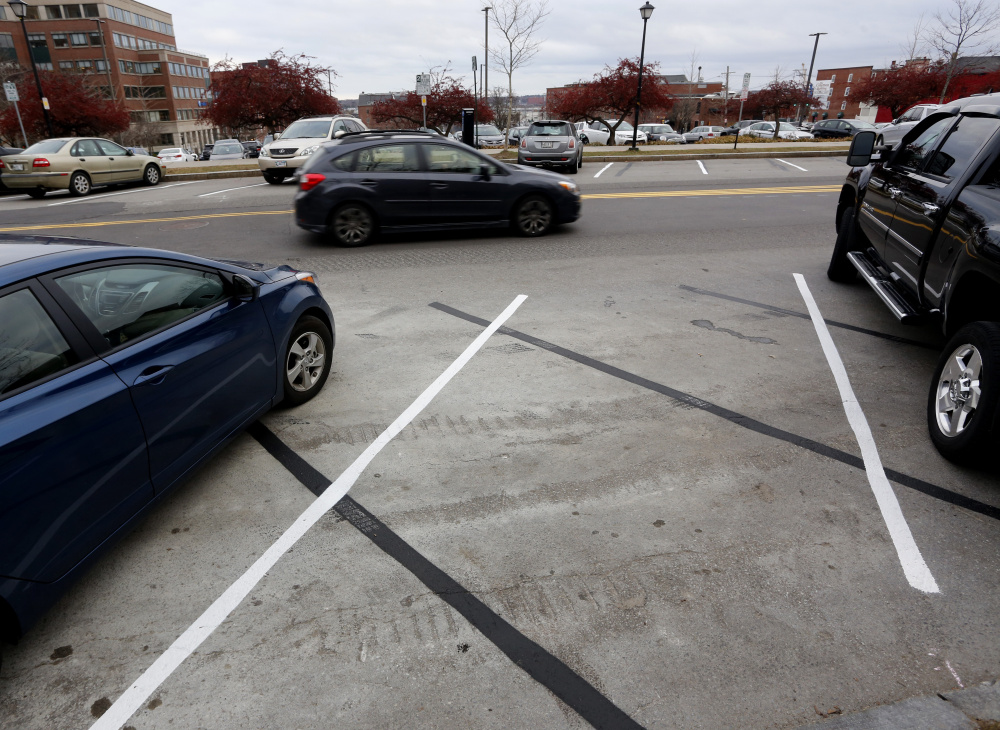Portland’s brief experiment with back-in angled parking along Spring Street is a failure, according to city staff.
City Manager Jon Jennings said in a memo to councilors Friday afternoon that when the Maine Department of Transportation paves Spring Street next week, the parking spaces will be switched to angled, nose-in spaces.
The back-in spots caused confusion for some motorists, especially when first created in December. However, the switch is being made mostly because city parking staff members have expressed concerns about having to walk in the travel lane to determine whether vehicles have paid for parking, Jennings said. The city’s pay-and-display system requires drivers to place a ticket on their dashboard.
The change was recommended by city planning staff in a memo dated April 20.
“I concur with their memo mostly because I am concerned about the safety of city staff walking in a busy street to monitor parking compliance. I do believe we should continue to look at other areas of the city where back-in parking makes sense and eliminates any safety concerns,” Jennings said.
CURB BUMP-OUTS UNPOPULAR
The switch is the latest reversal of a controversial redesign of the road connecting the West End to the Old Port.
Last December, construction crews reduced the size of a curb extension, or bump-out, at the corner of Spring and High streets after getting complaints from residents and commuters, who launched a petition effort. The sidewalk extensions into what had been travel lanes caused confusion for motorists. A reporter videotaped one vehicle driving onto the sidewalk extension, which is intended to enhance the safety of pedestrians.
Later, the city had to repaint the lines for parking spots along Spring Street between High and Temple streets. Crews mistakenly painted angled spots for vehicles to drive in nose-first and back out. It later switched those spots to angled back-in parking, prompting complaints from commuters. The city then installed signs explaining the new system and posted a video on its website.
Although complaints have been made about the sidewalk bump-outs at Spring and Temple, those will remain. Constructions crews on Friday were doing some work at those locations for traffic signals.
Jeff Levine, the city’s planning and urban development director, said in a memo that, in addition to the parking enforcement challenges cited by Jennings, the new arrangement was particularly problematic for out-of-town visitors going to the Cross Insurance Arena or the Holiday Inn by the Bay. Frequent stoppages of traffic when people back into their spaces also were a problem, he said.
But staff is not ready to totally abandon the concept, which appears to be working on Portland Street, a less busy one-way road in Bayside.
“We would particularly recommend exploring its use on one-way streets and in locations with documented high volumes of bicycles,” Levine said. “In addition, it is more appropriate for locations where there are fewer one-time visitors who need to learn how to use the parking correctly.”
JUST WHAT IS SAFEST?
Changes to Spring Street were part of the city’s Complete Street policy, which aims to make roadways safe and accessible to all forms of transportation, including bikes and pedestrians.
The project originally was intended to be part of a major, $4.5 million overhaul of Spring Street. Once envisioned to have wider sidewalks and enhanced street plantings, the project was scaled back because of the costs.
The city is moving forward with only $600,000 worth of work, which includes eliminating the concrete road median, adding bump-outs and new road striping to include bike lanes, and instituting angled parking along the street. Reducing the bump-out at Spring and High streets added an estimated $7,000 to $10,000 to the project.
The bump outs are designed to improve pedestrian safety by reducing the crossing distances. Bike and pedestrian advocates typically favor angled back-in parking, so drivers have better visibility when pulling into traffic.
City Councilor Spencer Thibodeau said he was concerned that cyclists were made less safe by the back-in parking, because people were pulling out of their spaces faster and were more focused on where they were going, rather than looking for cyclists. He is also sympathetic to the safety concerns of parking enforcement staff.
“It’s not an easy decision,” Thibodeau said. “I support back-in parking, but not at the expense of safety of our city employees.”
COUNCIL EVENLY SPLIT
City Councilors discussed the parking situation at an April 11 meeting. Jennings was hoping the council would tell him how to proceed, but councilors were evenly split.
Before Jennings announced his decision to councilors on Friday, Mayor Ethan Strimling was among those who supported the back-in parking. He said he has received few complaints recently. Four other councilors reported similar results. “I’m supportive of seeing if we can give it a little more time,” he said.
City Councilor Belinda Ray also prefers back-in parking, rather than the nose-first parking that exists on Commercial Street.
“I hate backing out on Commercial Street,” said Ray, who was sympathetic to staff concerns. “There’s always traffic and I feel like I’m going to get hit.”
The paving project is being done by the state. MDOT spokesman Ted Talbot said crews will begin milling Spring Street next week, with paving beginning on May 9. New pavement will be placed on Spring Street from State to Temple streets and on Middle Street from Temple to Franklin streets. Temple Street will also be paved.
Talbot said the work should be done by June 2, weather permitting, and commuters can expect alternative one-way traffic.
The city said in a press release Friday afternoon that crews will also be paving Commercial Street and a portion of Franklin Street beginning May 2 and continuing through June 3. The paving will be done in six phases, each of which is expected to last three to five working days, with work concluding around June 3. Deliveries and parking will be prohibited in work zones. Two-way traffic will be maintained as much as possible. Motorists should expect delays.
Copy the Story Link
Send questions/comments to the editors.






Success. Please wait for the page to reload. If the page does not reload within 5 seconds, please refresh the page.
Enter your email and password to access comments.
Hi, to comment on stories you must . This profile is in addition to your subscription and website login.
Already have a commenting profile? .
Invalid username/password.
Please check your email to confirm and complete your registration.
Only subscribers are eligible to post comments. Please subscribe or login first for digital access. Here’s why.
Use the form below to reset your password. When you've submitted your account email, we will send an email with a reset code.